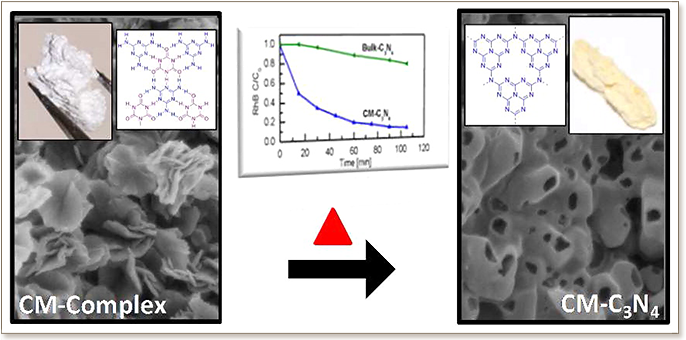 Here we report a new and simple synthetic pathway to form ordered, hollow carbon nitride structures, using a cyanuric acid-melamine (CM) complex in ethanol as a starting product. A detailed analysis of the optical and photocatalytic properties shows that optimum hollow carbon nitride structures are formed after 8h of condensation. For this condensation time, we find a significantly reduced fluorescence intensity and lifetime, indicating the formation of new, nonradiative deactivation pathways, probably involving charge-transfer processes. Enhanced charge transfer is seen as well from a drastic increase of the photocatalytic activity in the degradation of rhodamine B dye, which is shown to proceed via photoinduced hole transfer. Moreover, we show that various CM morphologies can be obtained using different solvents, which leads to diverse ordered carbon nitride architectures. In all cases, the CM-C3N4 structures exhibited superior photocatalytic activity compared to the bulk material. The utilization of CM hydrogen-bonded complexes opens new opportunities for the significant improvement of carbon nitride synthesis, structure, and optical properties toward an efficient photoactive material for catalysis.
Here we report a new and simple synthetic pathway to form ordered, hollow carbon nitride structures, using a cyanuric acid-melamine (CM) complex in ethanol as a starting product. A detailed analysis of the optical and photocatalytic properties shows that optimum hollow carbon nitride structures are formed after 8h of condensation. For this condensation time, we find a significantly reduced fluorescence intensity and lifetime, indicating the formation of new, nonradiative deactivation pathways, probably involving charge-transfer processes. Enhanced charge transfer is seen as well from a drastic increase of the photocatalytic activity in the degradation of rhodamine B dye, which is shown to proceed via photoinduced hole transfer. Moreover, we show that various CM morphologies can be obtained using different solvents, which leads to diverse ordered carbon nitride architectures. In all cases, the CM-C3N4 structures exhibited superior photocatalytic activity compared to the bulk material. The utilization of CM hydrogen-bonded complexes opens new opportunities for the significant improvement of carbon nitride synthesis, structure, and optical properties toward an efficient photoactive material for catalysis.